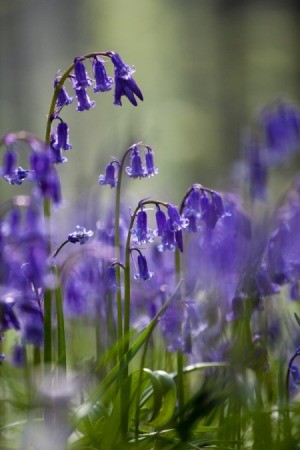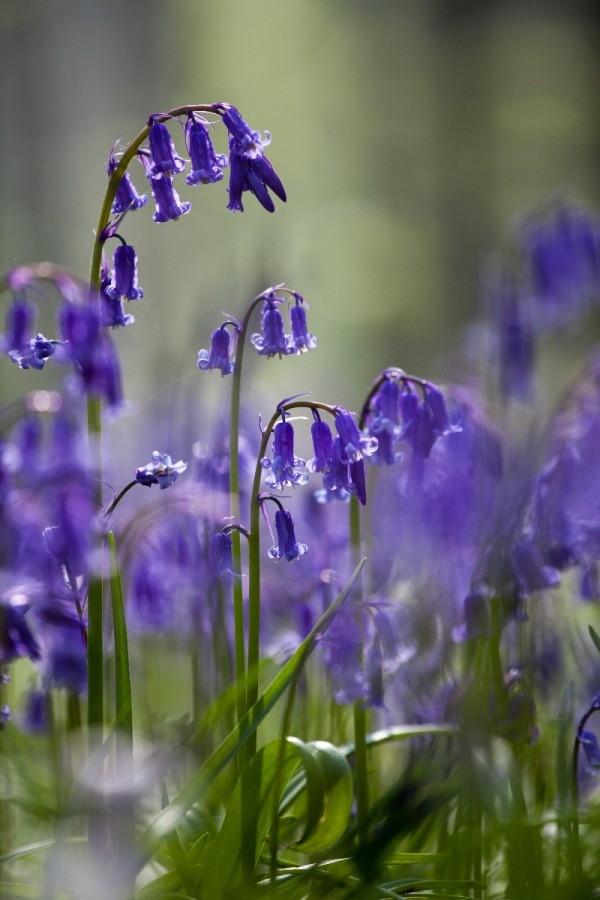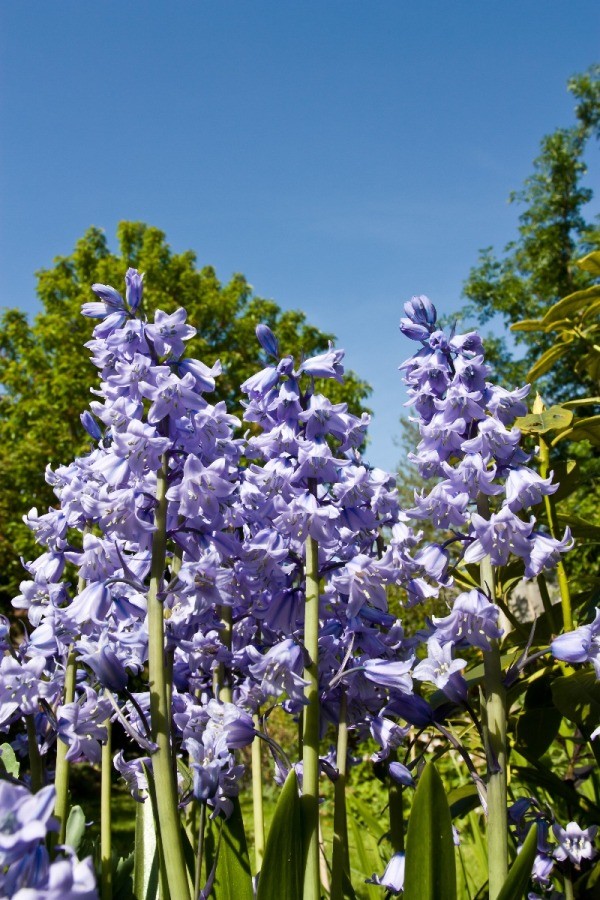 Hyacinthoides is a genus in the family Hyacinthaceae. It includes
Hyacinthoides is a genus in the family Hyacinthaceae. It includes
H. non-scripta the English bluebell (also known as wood hyacinth) and H. hispanica, a separate species. The two species have been know to hybridize in areas where their growing zones overlap, producing fertile offspring known as Hyachinoides x massartiana. The hybrid is quite vigorous and can easily replace the native species. They are all spring flowering.
Choosing the right bluebell for your garden is mainly contingent on your climate. The Spanish bluebell is the only viable choice, in the US, for gardeners in climates similar to lowland California. Globally, similar climates apply, as this species comes from Spain and North Africa. The English bluebell prefers colder winters and moderate to cool summers.
Let us begin with the English bluebell (Hyacinthoides non-scripta). This species originated in western Europe and its habitat extends from northwest Spain to the British Isles, where it reaches its greatest density. These perennial wild flowers bloom in spring and are characterized by drooping bluish-purple trumpet shaped blooms. The flowers are arranged along one side of the nodding stem. The blooms have a strong, sweet scent. An interesting feature of the bluebell is its contractile roots. When these roots contract they pull the bulbs down to find layers containing more moisture.
The English bluebell is an inhabitant of deciduous woodlands, but can be found in more open areas in some parts of its habitat. They prefer slightly acidic soils. The flowers are rich in pollen and nectar and are typically pollinated by bumblebees. They can reach a height of 10 inches.
Because of their preferred woodland habitat English bluebells are frequently found in garden settings growing under trees. Both English and Spanish bluebells can be easily naturalized in your garden.
The Spanish bluebell (Hyacinthoides hispanics, is hardy in zones 3 - 8 according to the USDA. It grows to a height of 9 - 18 inches, from small bulbs and propagates from bulb offsets and under the right conditions is also self seeding. The flowers of the Spanish bluebell are typically lighter in color than their English cousins and only have a slight scent. In addition to the typical blue color these bluebells are also available in white, pink, lavender-pink, and rose.
The Spanish variety is much less fussy about soil and light conditions. Once established they can even do well in dry shade, a tough spot for many garden plants. As with other spring-blooming bulbs they are typically planted in the fall. This gives them time to root and exposes them to the colder weather needed for most bulbs to bloom.
Plant the bulbs 2 - 4 inches deep or 4 times the depth of bulb size, several bulbs can be placed in the same hole. Bulbs not planted in fall can be stored in a cold place over the winter and planted in early spring. Bluebells are very hardy and tolerant of delayed planting. Bulbs not planted in spring can be stored over the summer in a cool, dry, spot. You may layer them in sawdust to ensure that they remain dry and do not mold.
Once your bells have bloomed, contrary to what you may have seen some gardeners do, do not cut back the foliage. The leaves gather sunlight needed for the process of photosynthesis which feeds and strengthens the bulbs for future seasons. Once the leaves yellow and die back they can be removed to cleanup your garden.
As noted bluebells prefer partially shaded locations, but can grow in full sun in coastal areas. While loam is the best type of soil for your bells, they will also do well in clay soils that have some organic materials added.
Bluebells quickly multiply and can fill your garden. If you choose to divide them, do so in the fall. Discard damaged bulbs. Then you can replant in the same bed, a new location, or give some away.
Bluebells are an easy to care for flowering bulb. As noted they quickly multiply to fill your garden. This can be a good thing if you are trying to naturalize an area or it can tip them into the weed camp if they grow out of control. They can also seed freely and produce new plants that way as well. These bulbs are so hardy that they can survive your compost heap. The best method of getting rid of too many bells is to dig them out. It is easier to find the bulbs while they still have leaves present. Dig down below the level of the bulbs to help ensure that you find them all.
These easy to grow, inexpensive bulbs make a great addition to the spring garden. Give them a try.
Source: The New Sunset Western Garden Book, Wikipedia, Gardening Know How website, the Royal Horticultural Society website, and years of personal experience in both the love and hate scenario.
Here are the questions asked by community members. Read on to see the answers provided by the ThriftyFun community.
 This Spring flower came up in my flower bed, but I don't know what it is. It comes up on a stalk and has small purple bell shaped flowers.
This Spring flower came up in my flower bed, but I don't know what it is. It comes up on a stalk and has small purple bell shaped flowers.
Hardiness Zone: 8a
By Janus from Gainesville, GA
It is a bluebell. I have hundreds in my front yard. They are very pretty and very prolific. Love them or hate them.
Barbara
It's a bluebell, but contrary to the name I also have pink,mauve and white ones in my garden in the UK. They are very invasive and take a lot of getting rid of.
I already ordered 80 English bluebells. I have read we are too warm where I live, but I want to try. I am in Gainesville, Georgia. We have 2 acres with heavy woods and some lake front.
Is it possible I can make a go of these? My husband is from Scotland and really wanted the bluebells.My gardening books don't even agree on this plant, if you ordered them, plant them and try. They grow best in zones 4-9, in the spring.
You live in either 7B or 8A gardening zone. According to the Breck's website, it is suited for zones 5-8. I am not sure how much light your property has or how well drained the soil is, so here is the link to the website: m.brecks.com/
I'm from the UK, I live in Atlanta . I ordered Bluebell bulbs in the fall. They are growing well, but i did put a lot of organic matter down several months before I planted them
Check out these photos.
Years ago, I brought foxglove plants from England wrapped carefully in a wet towel and put in a plastic bag. Somehow, English Bluebells must have been dug up at the same time and came with them.